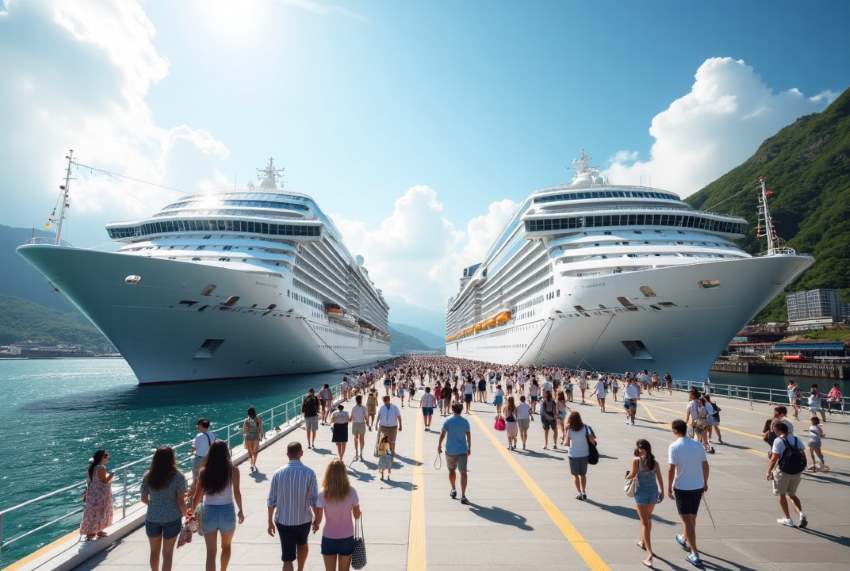Published on
October 25, 2025
South Korea is focusing on the global cruise tourism industry to attract one million cruise tourists by 2027. To achieve this goal, the government is boosting investments in the country’s cruise facilities. The Ministry of Culture, Sports, and Tourism and the Ministry of Oceans and Fisheries are investing in several projects to promote South Korea as an attractive cruise destination and strategically offer cruise services. New cruise terminals are being built and older ones are being expanded. Additional services to aid visitors are being implemented to promote ease of access to the world.
Major Infrastructure Developments
Infrastructure is critical to enhancing any cruise experience, and South Korea is concentrating on major cruise industry development projects to do just that. The new Saemangeum wharf, located in North Jeoll, is expected to welcome cruise tourism by 2026. This new wharf is Korea’s major investment in cruise tourism and is expected to expand options for cruise tourism docking. This new wharf will serve more international cruise vessels.
Along with the Saemangeum wharf, South Korea will build a new passenger terminal at Mukho Port, located in Gangwon, as part of developing more ports that can accommodate large cruise ships. More cruise ports are being looked into, further ensuring that South Korea can be a top country for cruise travel in the future.
The infrastructural improvements are being put in place to sharpen South Korea’s competitive marketing in the global cruise ship travel industry. The new cruise ports will cater to the customers’ need for a seamless and positive travel experience.
Increased Focus on Visitor Convenience
These improvements, though necessary to build the cruise ports, will only be part of the improvements South Korea will make. To improve efficiency, one of the first improvements will be to implement self-automated immigration controls at cruise ship terminals. International cruise ship travelers will spend less time waiting in line and more time sightseeing in the country.
In addition, port authorities will adjust the hours of operation at cruise terminals to give cruise lines more flexibility. Keeping the lines of the South Korean cruise port business open will make it more possible for guests to come and go at the times that South Korean cruise terminals will become operational.
The traffic flow and ease of accommodating guests seem to indicate the terminal flow business South Korea aims to grow.
Each of South Korea’s seven major cruise ports will continue to grow its distinct identity. For instance, Incheon will focus on “fly-and-cruise” plans. South Korea will have increasing ease for visitors as Incheon will allow guests to connect flights and cruises. Incheon will offer international visitors new opportunities as South Korea becomes more accessible.
Sokcho, known for being close to Mount Sorak, is marketing itself for those who love the outdoors. Visitors to the Sokcho port will enjoy a variety of cultural and natural features, and for the scenery, Mount Sorak is a bonus. By customizing the identity of each port according to nearby attractions and experiences, South Korea aims to give each traveler a unique and meaningful journey.
Marketing to Disperse the Benefits of Tourism
One of the main objectives of expanding the cruise business in South Korea is to distribute the profits gained from tourism evenly. According to the government, the cruise business is a fantastic way to disperse tourists from heavily populated cities like Seoul and Busan. This is intended to stimulate revenue in other parts of the country. Improving cruise infrastructure will allow more communities to engage in cross-border tourism. This is a significant positive revenue for the cruise business and helps the less-visited areas of South Korea.
The Korea Tourism Organization promotes the growth of cruise tourism as part of the overall tourism strategy for the country. South Korea aims to deliver a diverse tourism experience through distinctive regional offerings. In doing so, the country aims to become a cruise destination with an emphasis on sustainability and local community growth and development.
Goals for 2027
Planned developments to the South Korean cruise tourism experience demonstrate the government’s promise of prioritizing the cruise industry’s place as a pillar within the tourism strategy. The expected increase in cruise ships can be attributed to the ongoing development of new services and infrastructure to the care of domestic visitors as well as the establishment of distinctive identities for the country’s ports. By 2027, South Korea will be set to attract and cater to the appreciation of one million passengers annually.
The increase of cruise ships to South Korean ports is expected to increase global tourist confidence built through international travel, as well as the use of South Korean cruise services and facilities. South Korea will become a world cruise tourism destination. Increasing the cruise ports and refining services will increase South Korea’s prestige for global travelers.
Conclusion
By 2027, South Korea hopes to attract one million cruise passengers a year and showing how committed South Korea is to developing its tourism sector. Thanks to its tourism works infrastructure, targeting cruise ship services, and focused approach to regional port profiles, South Korea is getting ready to play a pivotal role in the worldwide cruise industry. South Korea focuses on customer ease and different, engaging, and sustainable experiences that provide cruise tourists and South Korean residents with a whole new approach to cruise tourism. The number of cruise tourists South Korea is equipped to host continues to grow. South Korea shows its commitment to this industry through meaningful levels of investment.


